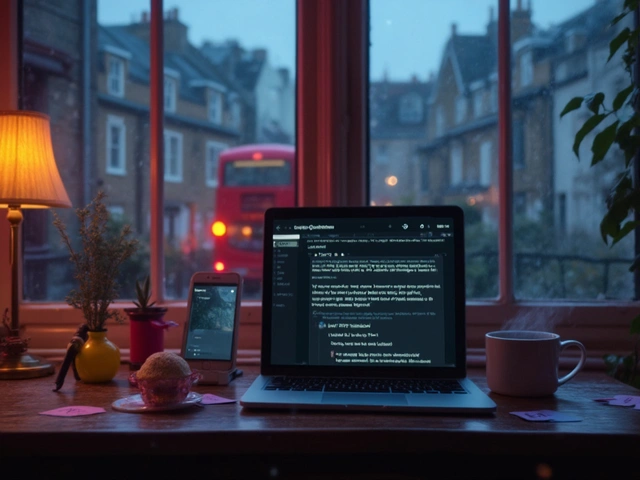Picture this: You pass a giant billboard for a new coffee shop on your drive to work, but later that day, an ad for the same place pops up on your phone while you scroll Instagram. Which one actually made you remember the name? That's the kind of head-to-head matchup businesses face daily—should they go digital, stick to tried-and-true methods, or mix the two?
In 2025, you can't just throw money everywhere and hope it works. For most small businesses (like the bakery up my street that gives my daughter Aurora her favorite blueberry muffins), every dollar needs to work hard. So, do you dump your budget into flashy online campaigns, lean on old-school flyers and radio, or find a clever blend?
Here's where things get interesting: Digital marketing can reach millions with a few clicks, but it’s noisy out there, and people scroll fast. Traditional ads like magazines or TV don’t let you track every eyeball, but research shows people tend to remember printed stuff just a bit longer. If you’re after quick boosts, digital is speedy and measurable, but traditional marketing hits differently when it comes to building trust.
- Cost and Reach: Who Gets More Bang for Your Buck?
- Measuring Results: Instant Data vs Waiting Games
- Flexibility and Personalization in Campaigns
- What Works for Different Businesses Today?
Cost and Reach: Who Gets More Bang for Your Buck?
If you’re running a business, money talks first. Digital marketing usually wins in terms of pure numbers. A Facebook ad campaign can start for as little as $5 a day, and you can narrow your audience down to exact ages, interests, and even zip codes. Compared to printing thousands of flyers or booking a TV spot, that’s loose change—and you don’t waste cash guessing who’s paying attention.
Let’s get specific. According to Datareportal, the average cost per thousand impressions (CPM) on Facebook is about $7.19, compared to TV at roughly $36 CPM. Google Ads will run about $2.50 CPC (cost per click) on average, while sending a print ad through direct mail averages $0.33 to $0.50 per household, but with no guarantee anyone even looks at it.
| Platform | Average CPM / CPC | Typical Reach |
|---|---|---|
| Facebook Ads | $7.19 CPM | Highly Targeted, Global |
| Google Ads | $2.50 CPC | Intent-based, Global |
| Direct Mail | $0.33–$0.50 per home | Local, Broad |
| TV Ads | $36 CPM | Regional/National |
| Magazine Ads | $20–$32 CPM | Demographic Profile |
But traditional marketing still has a superpower: it often sticks longer in people’s heads, especially if the audience isn’t hanging out online all day. Older folks or people in less digital-heavy communities might remember a billboard or radio jingle way more than anything scrolling by on TikTok.
“Digital marketing makes sense if you want measurable, efficient outreach fast. But don’t ignore the power of a print ad for the right crowd,” says Sarah Klein, director of Brandwave Marketing.
Quick tip: If you’re on a tight budget and want to hit young adults, focus your efforts on digital. If your customers are less online or you’re after trust, traditional marketing still earns its keep. The magic? Combine both. Set aside a chunk for social ads, but don’t ditch flyers or local sponsorships completely. Mixing channels gives you more ways to reach different people without blowing your budget.
- Start small: Run low-cost digital ads for instant feedback.
- Measure: Track not just clicks, but real-life visits or calls linked to promos.
- Test: If a print ad or event brings customers in, scale it up—if not, stick to the channels that drive results.
Bottom line: When it comes to cost and reach, digital marketing is unbeatable for tight wallets and detailed targeting. But don’t assume it’s the only way to win. The smartest brands pick and mix depending on their customers, not just trends.
Measuring Results: Instant Data vs Waiting Games
If you’ve ever run a Facebook ad and seen new likes come in before you even finish lunch, you know how wild digital marketing’s speed is. Nearly every platform—Google, Instagram, TikTok—lets you see real-time numbers: clicks, shares, comments, and even who clicked your ad. For example, Meta Ads Manager breaks down age, location, and times people tap your post. Google Analytics even shows if someone visited your site and left in ten seconds or stuck around for five minutes.
With digital marketing, you get instant feedback. You know what’s working, what’s flopping, and you can swap out an ad or try a new idea without restarting the whole campaign. This flexibility lets businesses make quick, smart decisions, sometimes on the same day. If you're working with a tight budget, this saves money since you’re not stuck paying for a bad ad for months. A 2024 HubSpot survey found that 61% of marketers prefer digital methods mainly because of these fast insights.
Traditional marketing, though, feels like sending a message in a bottle. When you run a print ad in the local paper or buy a radio spot, feedback takes forever. Did someone see your ad? Maybe. Did they call your office because of the billboard or word of mouth? You just don’t know right away. Sure, coupon codes or special phone numbers give you clues, but you’re often waiting weeks or months for results—and even then, it’s guesswork. The upside? Some old-school channels, like direct mail, do still have an average response rate of about 4.4% according to the Data & Marketing Association, way better than most email campaigns.
- Digital marketing gives instant, detailed stats for every campaign.
- Traditional marketing makes you wait but can still build strong, lasting impressions.
- Real-time data lets digital campaigns get optimized fast, so you waste less money.
- Offline approaches often rely on less precise measurement—even customer surveys or tracking sales spikes after an ad goes live.
If you’re the type who likes checking results like you check messages from your kids after school, digital marketing is pure gold. For those more patient (or aiming for big reputation boosts rather than quick sales), traditional might still do the trick.
| Marketing Type | Time to Measure Results | Level of Detail | Typical Tools |
|---|---|---|---|
| Digital | Minutes to hours | High: clicks, views, demographics | Google Analytics, Facebook/Meta Insights, TikTok Analytics |
| Traditional | Weeks to months | Low: rough estimates, surveys, sales trends | Coupon codes, unique phone numbers, customer surveys |

Flexibility and Personalization in Campaigns
Here’s what makes digital marketing a game-changer: you can switch things up on the fly. Say you launch a Facebook ad in the morning and notice by lunchtime that nobody’s clicking. No problem—adjust the headline, change the image, or even pause it. With traditional marketing, like a TV commercial or print ad, you’re stuck once it’s out there. No edits. No quick fixes. If you mess up a phone number on a flyer, tough luck.
Personalization is another big deal. When you Google “best sneakers for running” and then see an ad for sneakers on your next YouTube video, that’s hyper-targeting in action. Digital platforms collect data like age, location, shopping habits, and even whether you’ve abandoned a shopping cart. This lets brands serve up offers that actually fit what you want—sometimes almost a little too well.
- Email newsletters can use your name and recommend products based on your past orders. I just got one yesterday offering discounts on dog toys, because my son Felix keeps searching for them!
- Social platforms let you target ads by interests, jobs, and even if someone just got engaged.
- Retargeting tracks visitors who didn’t buy and nudges them with follow-up ads wherever they go online.
Compare that to traditional methods. You can personalize a postcard, sure, but it’s way less precise. Most print ads speak to everyone the same way, hoping the message lands with the right people. Changing something mid-campaign—like updating a phone number or swapping a picture—requires reprinting, sometimes wasting thousands of dollars.
Check this out: in a 2024 study, 74% of consumers said they get frustrated when content isn’t personalized. Another fun fact—brands that use advanced personalization grow revenue 40% faster (according to a Statista report from last year).
| Marketing Type | Easy to Change? | Personalization Level |
|---|---|---|
| Digital | Yes—edit instantly | High (name, interest, shopping habits) |
| Traditional | No—must reprint/remake | Low (basic location, broad group) |
The bonus with digital methods? A/B testing. Try two different ad versions at once, see what works best, then throw all your budget to the winner. You can’t split-test a TV ad without shelling out a fortune.
If you want your marketing dollars to stretch, and your brand to feel like it really “gets” your buyers, digital wins for flexibility and customization. But if you want to hit everyone in a neighborhood or those not online much, traditional still has a place at the table—though it’s definitely harder to keep things fresh or personal.
What Works for Different Businesses Today?
There’s no one-size-fits-all answer. The right approach depends on your business size, what you sell, and your goals. Let’s break it down with what’s actually working for different types of businesses in 2025.
Small local shops—like that family bakery or the barbershop down the street—still get solid results from some traditional moves: think flyers, local radio, and sponsoring a youth sports team. These tools build trust in their own communities. But even here, a basic digital setup can give a boost. Most customers check Google before visiting, so setting up a Google Business Profile and collecting positive reviews can make a big difference.
On the flip side, mid-sized retailers and service providers—gyms, legal services, real estate agencies—are leaning harder on digital marketing. Social ads (especially short TikTok or Instagram Reels), email newsletters, and customer retargeting campaigns help these businesses reach busy, distracted people where they already are: online. A 2024 HubSpot report found that 65% of businesses in this bracket saw their highest ROI from digital campaigns compared to TV or print.
Big brands? They’re mixing it all up. Pepsi, for example, still throws millions at Super Bowl commercials, but they also get huge online engagement by partnering with influencers for viral TikTok challenges. There's no "ditch traditional, go all digital" situation here—it’s about spreading the risk and tracking results.
Here’s a quick snapshot to compare what different business types are seeing in 2025:
| Business Type | Winning Tactic | Real-World Example |
|---|---|---|
| Local Shop | Google reviews + event flyers | Bakersfield Café tripled walk-ins after requesting customer reviews |
| Mid-Sized Service | Social ads + email follow-ups | Family Law Group saw 40% more leads from targeted Facebook ads in 6 months |
| Large Brand | Omni-channel: TV, print, digital, influencers | Nike’s "You Can’t Stop Us" campaign hit 5M YouTube views and got major TV exposure |
If you’re just starting out, don’t try to copy big brands blindly. Focus on one or two channels where your best customers hang out. Test cheap—like running a $20 Facebook ad or dropping 100 local flyers. See what replies or visits you get. Measure results, tweak, and scale up what really moves the needle for your type of business.
Bottom line: there’s no magic formula, but if you know what works for your business category and test smart, you’ll waste less cash and get more action.





